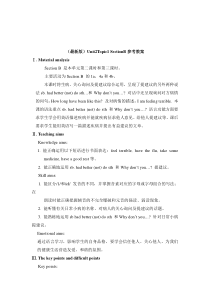 DOC
DOC
【文档说明】Unit 2 Topic 1《You should see a dentist》(SectionB)教案-八年级上册英语【仁爱版】.doc,共(8)页,48.500 KB,由小喜鸽上传
转载请保留链接:https://www.ichengzhen.cn/view-104238.html
以下为本文档部分文字说明:
(最新版)Unit2Topic1SectionB参考教案Ⅰ.MaterialanalysisSectionB是本单元第二课时和第三课时。主要活动为SectionB的1a,4a和4b。本课时将生病、关心询问及提建议综合运用,呈现了提建议的另外两种说法sb.
hadbetter(not)dosth…和Whydon’tyou…?对话中还呈现询问对方病情的问句:Howlonghavebeenlikethis?及对病情的描述:Iamfeelingterrible.本课的语法重点
sb.hadbetter(not)dosth和Whydon’tyou…?语言功能方面要求学生学会用英语描述疾病并能就疾病征求他人意见、给他人提建议等。课后要求学生能用英语写一篇描述疾病并提出有益建议的文章。Ⅱ.TeachingaimsKnow
ledgeaims:1.能正确运用以下短语进行书面表达:feelterrible,havetheflu,takesomemedicine,haveagoodrest等。2.能正确地运用sb.hadbetter(not)dosth和Whydon’tyou…?提建议。Skillaims
:1.能区分/1/和/eI/发音的不同,并掌握音素对应的字母或字母组合的写法;在朗读时能正确把握辅音的不完全爆破和元音的强读、弱读现象。2.能听懂有关日常小病的名称、对病人的关心询问及提建议的话题。3.能熟练地运用sbhadbetter(not
)dosth和Whydon’tyou…?针对日常小病提建议。Emotionalaims:通过语言学习,影响学生的自身品格,要学会信任他人、关心他人,为我们的健康生活营造友爱、和谐的氛围。Ⅲ.ThekeypointsanddifficultpointsKeypoints:feelterrible
,havetheflu,takesomemedicine,haveagoodrest等短语的理解及运用。Difficultpoints:理解Howlonghaveyoubeenlikethis?Ⅳ.Learningstrateg
ies1.巩固学生根据图片猜单词意思的能力。2.巩固学生模仿已有例句造句的能力。Ⅴ.TeachingaidsComputermultimediaprojector,chalk,blackboardEverydaysaying:Bitterpillsmayhavewholesomeeffec
ts.良药苦口利于病。Ⅵ.TeachingproceduresStepInteractionpatternStudentactivityTeacheractivity1.Thewholeclasswork2.Thewholeclasswor
k1.Focustheirattentionontheteacher.2.Studentssingtogether.1.Greetstudentsreadyforlearning.2.Singasongtogether.(Clapyourhandsif
youarehappy.)TeachershowtheChinesewordsonthescreen.Introduction(7minutes)3.Pairworkandindividualwork4.Somestudents’work5
.Thewholeclasswork6.Thewholeclasswork7.Thewholeclasswork3.Twopairsassignedbeforeclassgivethereport.4.Volunteersanswer:He/Shehasa…
5.Studentsfollowwhattheteachersays,andanswertogether“Shehasacold.”6.Studentsreadandfeelthefunctionof“terrible”.Thentheyguessth
emeaningoftheflu.7.Studentslookthroughthestatementsin1b,makingsuretheyknowwhattodo.3.Dailyreport.Tea
chercallstwopairstoreporttheirinterview“What’swrongwithyou?”.4.Teacherasksaquestion“What’swrongwith…?”to
checkifotherslistencarefullyandunderstandthereporter.5.Theteacherintroducesthenewwordsbyshowingapicturewith“terrible,abadcold,aterriblecold”onit.T
eacheraskswhilestudentsanswertogether:“What’swrongwithher?”6.Teachergoeson,“Shehasabadcold,shehasaterriblecold.Maybesh
ehastheflu.”Whileshowingthepicture“flu”,whichmeans“abadcold,aterriblecold”.7.Teacherleadsto1a:“SteveandBruceare
talkingaboutillness.Let’slistenandfinish1b.”Presentation(10minutes)1.Thewholeclasswork2.Thewholeclasswork3.Thewholeclassw
ork4.Thewholeclasswork5.Thewholeclasswork6.Thewholeclasswork7.Thewholeclasswork1.Studentsunderstand“suggestion”byunderstandingwhatth
eteachersays.2.Studentslistenandfinish1b.3.Studentslookthrough1candmakesurewhatthestatementsmean.4.Studentslistencarefully,andthend
iscusstheiranswersafterlistening.5.Studentsreadindividually,andthencorrecttheiranswersto1band1cwhilereading.6.St
udentsreadaftertherecordingonebyone.7.Studentsreadatthesamespeedastherecording,tryingtoimitatetherecording.1.Teacherexplainsthat“su
ggestion”isthenounformof“suggest”.2.Teacherplaystherecordingof1a.3.Teacherasksthestudentstolookthrough1candmakessuretheyunderstandthestatements
.4.Teacherplays1a.5.Teacherletsstudentsread1aindividually,checking1band1c.6.Teacherplaystherecordingsentencebysentence.7.Teacherplaystherec
ordingwithoutstopping.Consolidation(10minutes)1.Thewholeclasswork2.Thewholeclassworkandpairwork3.Pairwor
k4.Thewholeclasswork5.Groupwork6.Groupwork1.Studentsunderlinethepointsintheirbooks,makingsuretheyunderstand
themeanings.2.Studentsreadinpairs.3.Eachgroupchoosesoutapairtoread,andtheymakethescoresasusual:A-5;B-6;C-7.4.Stu
dentsread2silently,andthennumberthestatements.5.Eachgroupwritestheiranswersontheblackboard.6.Eachstudentreadsonesentencetofinishthe
wholedialogue,butnooneknowswhoisthenexttoread.1.Teacherexplainssomelanguagepointsforthestudents.(1)Howlonghaveyoubeenlikethis?(2)You’dbettertakesome
medicine.(3)feelterrible←→feelwell,bewell(4)havetheflu(5)takesomemedicine(6)takeyoutothehospital(7)havearest(8)gotoseeadoctor2.T
eacherasksthestudentstoread1ainpairs.3.Teacherasksthreepairstoreadthedialogueforthewholeclass.4.Teacher
asksthestudentstofinish2.5.Teacherchecksthestudents’answers.6.Teacherasksthestudentstoreadthedialogueinchains,andthefirstonewhofini
shesreadingcanpointanyoneintheirgroup,soasthefollowingone.Practice(10minutes)1.Thewholeclasswork2.Thewholec
lasswork3.Groupworkandindividualwork4.Thewholeclasswork5.Pairwork6.Groupwork7.Pairwork1.Studentstrytounderstand“c
andy”bylookingatthepictureandunderstandingwhattheteachersays.2.Studentstrytounderstand“brush”bylookingatthepictureandunderstandingw
hattheteachersays.3.Everystudentmakeshis/herowndialogue,withverbphrasebeingassignedfirst.4.Studentsuse“l
iedown”intheirownconversations.5.Sixpairsfromdifferentgroupsshowtheirperformance.Thebesttwopairswillread4aand4b.6.Thefirstgroupread4a,ifth
eyarewrong,thesecondgroupcorrect,andviceverse.7.Thelosersread4aand4b,iftheydon’treadcorrectly,thewinnerswilltapthelosers,
hands.8.Studentsreadaftertherecording,tryingtoimitatethepronunciationandintonation.1.Teachershowsapi
ctureof“candy”,saying“Candyissweet,andchildrenlikeeatingcandy.Oldpeopledon’tlikecandy,becauseeatingtoomuchcandy
isn’thealthyandit’sbadforourteeth.”2.Teachershowsapictureof“brush”,saying“Brushyourteethafteryoueatcandy.”3.Teacher
asksthestudentstomakenewconversations,andeachgrouphastomakeupfivedifferentconversations.4.Teacherexplains“liedown”byshowingtw
opicturestocompare“stand”and“liedown”whilestudentsmakethedialogue.5.Teacheraskssixpairstoreadtheirconve
rsations,andthebesttwopairswillread4aand4b.6.Teacherchecksthetwogroups.7.Teacherasksthestudentstoplayfinger-g
uessinggamesinpairs,andthewinnerswillchecktheloserstoread4aand4b.8.TheteacherplaystheProduction(8minutes)1.Thewholeclassworkandindividualwor
k2.Thewholeclasswork3.Thewholeclasswork4.Individualwork1.Eachstudentinterviewsfivestudents.2.Studentswritetheirinterv
iewafterclass,preparingforthereportinthenextclass.3.StudentssummarizeSectionAwiththeteacherbydoingexercisesshownonthescreen.4.Studentsdothefo
llowingjobs:(1)Memorizethesummaryafterclass.(2)Studentswritetheinterview“What’swrongwithyou?”aftercla
ss,andprepareforthereportinthenextclass.(3)StudentslearntoreadvocabularyinSectionCwiththehelpofrecordingandthephoneticsymbols,andreadthedialogaftert
herecording.1.Teacherorganizesaninterviewaccordingto3,andstudentswillinterviewatleastfivestudents.2.Te
acherasksthestudentstowritedowntheirinterviewafterclass.3.Teachershowsthesummarytothestudents.(1)Vocabulary(2)thestructure:willdo4.Teacher
assignshomework:(1)Reviewthesummaryafterclass.(2)Reporttheirinterviewtothewholeclassinthenextclass.(3)PrepareSectionCafte
rclass.TeachingReflectionStudentsareinterestedininterviewingothersandgivingsomeadvice.Buttherearetoomanyverbphra
ses,studentsneedtomemorizetheEnglishverbphrasesafterclass.Ⅶ.BlackboarddesignUnit2KeepingHealthyTopic1Youshouldseeadentist.SectionBWhat’swrongwit
hyou?I’mfeelingterrible.Howlonghaveyoubeenlikethis?Youhadbettertakesomemedicine.Youhadbetternotworktoolong.Whyd
on’tyouhaveagoodrest?
 辽公网安备 21102102000191号
辽公网安备 21102102000191号
 营业执照
营业执照